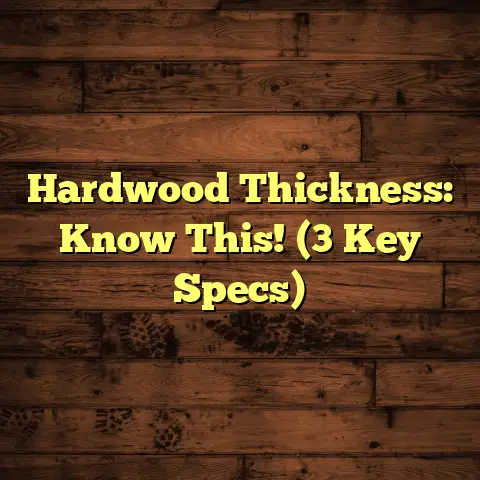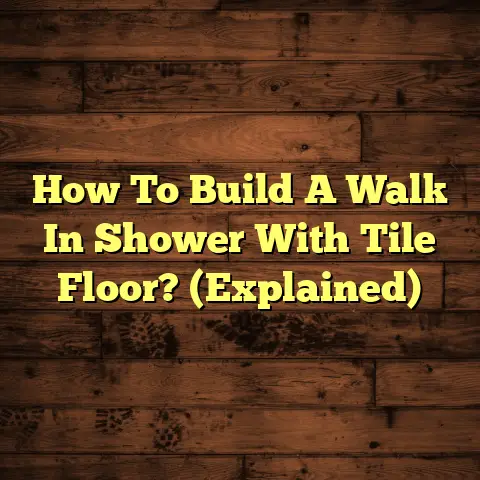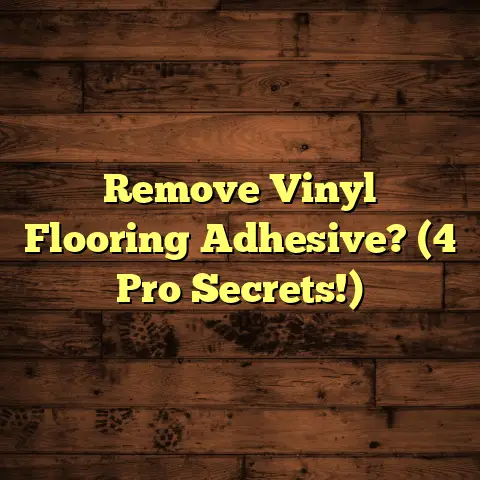Refinishing Wood Floors Cost? (4 Price Shock Factors!)
Did you know that the National Wood
Flooring Association says almost 90%
of us in the US pick hardwood for our
homes?
It’s all about that classic
look and how long it lasts.
But let’s be real: those gorgeous floors
don’t stay perfect forever.
That’s
where refinishing comes in.
Now, before you jump in, let’s talk
money.
I’m going to break down the
real costs of refinishing wood floors,
and trust me, there can be surprises!
Understanding the Basics of
Wood Floor Refinishing
So, what does “refinishing” even mean?
Basically, we’re sanding down the top
layer of your wood floor to get rid of
scratches, dents, and that worn-out
look.
Then, we apply a fresh coat of
stain and sealant to protect it.
It’s like giving your floors a brand-new lease on life!
There are tons of wood floor types out
there: oak, maple, pine, even bamboo.
Each one has its own quirks and reacts
differently to refinishing.
Why do people refinish their floors?
- Wear and tear: Obvious scratches, dents, and dullness.
- Aesthetic updates: Changing the stain color to match your style.
- Home sale prep: Making your place look its best for potential buyers.
Price Shock Factor #1:
Type of Wood Flooring
Okay, let’s get into the nitty-gritty.
The type of wood you have makes a HUGE difference in the cost.
Think about it: some woods are harder than others, requiring more effort and specialized equipment to sand down.
Oak is usually the most budget-friendly to refinish because it’s common and relatively easy to work with.
Maple and cherry? They’re denser, so expect to pay a bit more.
Exotic woods, like Brazilian cherry or
tigerwood, can really bump up the price.
They might need special sanding techniques
and specific types of finishes.
And what about solid hardwood versus engineered wood?
Solid hardwood can be sanded and refinished multiple times, while engineered wood has a thinner top layer.
This means you might only get one or two refinishing jobs out of it, and you need to be extra careful not to sand too deep.
I did a job last year where the homeowner
thought they had solid oak, but it turned
out to be engineered with a super thin
veneer.
We had to stop halfway through
because we were hitting the core!
Let me give you a rough idea of the cost difference, based on my experience:
Keep in mind, these are just averages. Always get a quote from a pro!
Price Shock Factor #2:
Condition of the Floors
Alright, let’s talk about the shape your floors are in.
A little wear and tear is one thing, but
major damage?
That’s a whole different ballgame.
Minor scratches and a bit of dullness are
pretty standard.
We can usually fix those
with a simple sanding and refinishing.
But what if you have:
- Deep gouges or dents?
- Water damage or stains?
- Missing or broken boards?
- Pet stains?
These issues require extra steps, like:
- Wood filler: To patch up small holes and imperfections.
- Board replacement: Removing and replacing damaged boards.
- Stain removal: Using specialized products to lift stubborn stains.
I once worked on a house where the
previous owners had let their dog run
wild.
The floors were covered in deep
scratches and, well, let’s just say
“accidents.” We had to replace a good
chunk of the wood before we could even
think about sanding!
Here’s how the condition can affect the price:
Remember, it’s always best to get a
professional assessment.
They can spot
hidden problems you might miss.
Price Shock Factor #3:
Geographic Location
Okay, this one might seem obvious, but it’s worth mentioning.
Where you live can seriously impact the cost of refinishing your wood floors.
Urban areas tend to have higher labor
costs and overhead expenses for
contractors.
Plus, parking and access
can be a pain, which can add to the bill.
Rural areas might have lower labor costs,
but the availability of contractors and
specialized materials could be limited.
This could drive up prices if you need
something specific.
I’ve noticed that refinishing costs are generally higher on the coasts (think California and New York) compared to the Midwest.
This is due to a combination of factors, including higher cost of living, stronger demand, and stricter regulations.
I did some research on national averages, and here’s a rough idea:
- National Average: \$3 – \$8 per sq ft
- Major Metro Areas: \$5 – \$10+ per sq ft
- Rural Areas: \$2 – \$7 per sq ft
Keep in mind, these are just ballpark
figures.
The best way to get an accurate
estimate is to contact local contractors
in your area.
Price Shock Factor #4:
Professional vs. DIY Refinishing
Alright, the big question: should you hire a pro or tackle this yourself?
DIY refinishing can seem tempting.
You save on labor costs, and you get
the satisfaction of doing it yourself.
But let me be blunt: it’s not for everyone.
Refinishing wood floors is hard work.
It requires specialized equipment,
technical skills, and a lot of patience.
If you mess up, you could end up damaging your floors and costing yourself even more money in the long run.
Here’s a breakdown of the pros and cons:
Professional Refinishing:
- Pros:
- Expertise and experience
- High-quality results
- Less hassle for you
- Warranty on their work
- Cons:
- Higher upfront cost
- Need to schedule and coordinate
DIY Refinishing:
- Pros:
- Lower upfront cost
- Flexibility to work on your own schedule
- Sense of accomplishment
- Cons:
- Requires time, effort, and skill
- Potential for mistakes
- No warranty
Let’s talk about costs.
If you go the DIY
route, you’ll need to factor in:
- Sander rental: \$50 – \$100 per day
- Sandpaper: \$20 – \$50 per project
- Stain and sealant: \$50 – \$100 per gallon
- Applicators and tools: \$20 – \$50
That might seem cheaper than hiring a pro, but remember to factor in your time and potential mistakes!
I know someone who tried to refinish their
floors themselves and ended up with
uneven sanding, blotchy stain, and a
huge headache.
They eventually had to
call in a professional to fix the mess,
which cost them even more than if they’d
hired someone in the first place!
I always recommend getting at least three
quotes from different contractors.
Ask about their experience, their process,
and their warranty.
Don’t be afraid to ask questions and negotiate!
Conclusion
So, there you have it: the four biggest price shock factors when it comes to refinishing wood floors.
- Type of wood
- Condition of your floors
- Geographic location
- Professional vs. DIY
The key takeaway?
Do your research, get
multiple quotes, and be prepared for
unexpected costs.
Refinishing your wood floors can be a fantastic investment, but it’s important to go in with your eyes wide open.
Good luck, and happy refinishing!





